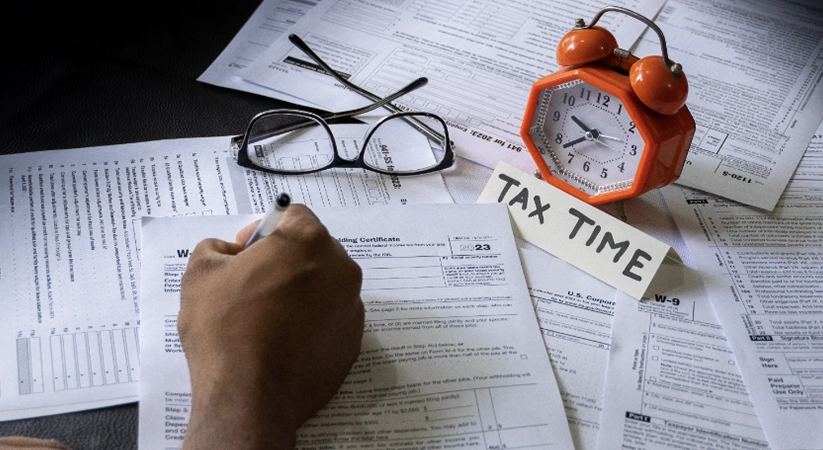
So the ol’ “Dog ate my W-2” excuse won’t work?
Filing your taxes can be a daunting task, especially when you do not have all the necessary forms. It can be even more challenging when you don’t receive your W-2 form, which is typically provided by your employer.
However, the fact that you don’t have this form should not discourage you from filing your taxes. There are other steps you can take to ensure you file your taxes correctly.
Let’s cover how to file taxes without a W-2 and still stay legal, as well as tips to help you avoid legal difficulties if you find yourself in a situation where your employer fails to provide you with the necessary documentation.
What You Can Do If You Don’t Get a W-2 Form
It’s tax season once again, and one of the most important forms you have to receive is your W-2 form. This document is crucial for accurately filing your tax return and getting your tax refund. Unfortunately, there are instances when you don’t receive your W-2 form, and it can lead to confusion and stress.
If you haven’t received your W-2 form from your employer by February 16, don’t panic! There are alternative methods to ensure accurate and timely tax filing.
Missing W-2
Start by requesting your W-2 form from your employer. Companies are required to provide W-2 forms to their employees by January 31st. If you still haven’t received it by mid-February, follow up with your human resources department or employer. They may have the wrong address on file or have experienced a delay. If the company isn’t around anymore, the former payroll provider can actually handle any requests for a W-2 form.
If you are unable to obtain your W-2 form from your employer, you can still file your taxes by completing Form 4852, Substitute for Form W-2. This form allows you to provide an estimate of your wages and taxes withheld. Keep in mind that this may delay your tax return processing.
Another option is to request a Wage and Income Transcript from the IRS. This transcript includes information about your wages and taxes withheld, which can be used to file your taxes accurately.
However, this may take several weeks to receive.
How do I file taxes if I don’t know how much I earned?
If you do not know how much you earned, there are still ways to determine your taxable income. The first step is to check your final paycheck for the year-to-date pay. This will give you an idea of how much you have earned over the year.
You will also need to gather your employer identification number, address, social security information, and the amount of taxes withheld from your pay. These details can be found on your pay stub or a previous W-2 form. Once you have this information, you can use a tax software or consult with a tax professional to help you calculate your taxable income. Remember that your taxable income is the amount of income left after subtracting deductions and exemptions.
It is crucial to accurately report your taxable income to avoid legal difficulties and potential financial losses.
If you are unsure about any information or have trouble obtaining your pay information, speak with your employer or a tax professional for assistance.
Is It Against the Law to File Federal Tax Returns Without a W-2 Form?
The answer is no, but with some important caveats. Technically, it is possible to file taxes without a W-2 if you are using tax software or an experienced tax preparer. However, it is crucial to keep in mind that the information from the W-2 is necessary to accurately calculate your taxes. Failing to provide accurate information could result in an audit or penalties from the IRS.
Furthermore, it is important to keep your W-2 in a safe place as it may be required for background checks, audits, or other legal situations. Failing to produce a W-2 could also have legal consequences, such as the liability for back taxes or penalties.
In conclusion, it is possible to file taxes without a W-2, but it is not recommended. It is important to accurately report all income and to keep important tax documents in a secure location to avoid legal difficulties.
Request Your Wage and Income Transcript Online or by Mail
If you’re missing your W-2 form from your employer, you can still file your taxes by obtaining a copy of your Wage and Income Transcript directly from the IRS. This transcript will show all the income and taxes withheld reported to the IRS by your employer(s) for the tax year.
You can request a transcript by filing Form 4506-T or Form 4506T-EZ by mail or fax. Alternatively, you can also access your transcript online for immediate download if you pass the identity verification process. Another option is to use Form 4852 as a substitute for your W-2. Fill it out with as much information as possible, including your wages and taxes withheld, and use it to file your tax return. However, keep in mind that the IRS may take longer to process returns filed with Form 4852, and you may need to provide additional documentation later. Remember to file your federal income tax return by the deadline to avoid late-filing penalties and interest.
Missing W-2 Form? Complete Form 4852 and Use Your Last Pay Stub.
No W-2? Download and fill out Form 4852 instead. It’s available for download on the official IRS website, and you can use a copy of your latest pay stub to complete it correctly.
To begin, provide your personal information, including your name, Social Security number, and address. You’ll also need to include information about your employer, such as their name, address, and employer identification number.
Next, you’ll need to report your wages and taxes withheld for the year. Use your latest pay stub to ensure the most accurate information, including any other types of income you may have received.
Then, request a Wage and Income Transcript from the IRS to verify the income reported by your employer. You can use the Get Transcript Online tool on the IRS website. Or you can also request your transcript with Form 4506-T. This transcript shows all of the income and tax withholding information that the IRS has received from your employers, banks, and other payers. However, it’s important to note that these transcripts may not be available until July.
Once you have received your Wage and Income Transcript, review it carefully to ensure that it matches the information reported on your Form 4852. Compare the amounts of income reported, as well as any taxes withheld.
After completing the 4852 form, make sure to attach it to your tax return, along with any other required forms. If you notice any discrepancies, contact the IRS for further assistance. By obtaining a Wage and Income Transcript, you can ensure that your tax filing is accurate and avoid any potential legal difficulties.
Send it to the IRS as soon as possible to avoid any potential legal consequences or difficulties.
Employers’ Legal Responsibilities Regarding Your W-2
As an employer, it’s important to know and comply with your legal responsibilities when it comes to providing W-2 forms to your employees. The W-2 form is a crucial document that reports an employee’s earnings, social security wages, and taxes withheld during the previous tax year.
The Internal Revenue Service (IRS) requires employers to prepare and provide W-2 forms to their employees on or before February 1 of each year, and to also provide copies of those W-2 forms to various government organizations, including the Social Security Administration. Negligent employers may face legal consequences for not complying with these requirements, such as having to pay penalties and interest, facing legal difficulties, or facing a background check for tax-related issues.
It’s important to ensure that the W-2 form is accurate and complete, as errors or omissions could not only result in penalties for the employer, but they could also cause problems for the employee when filing their individual income tax return. In addition, oftentimes employers may need to provide separate items such as a 1099-NEC form or other substitute for the W-2 form.
What if my employer didn’t send a Form W-2?
If an employer fails to send a Form W-2 by the February 1 deadline, there are steps you can take to ensure that you meet your own tax deadline. The first step is to follow up with the employer and request the required document. Employers have certain responsibilities to provide their employees with accurate W-2 forms that reflect their Social Security wages and taxable income for the previous year.
If reaching out to the employer does not get a response or replacement, the IRS can intervene on your behalf.
You can call the IRS at 800-829-1040, and they will contact the employer and request that they send a replacement.
This can take some time, so it’s advisable to start this process as soon as possible. If the employer is deemed derelict and still fails to send a W-2 form, the IRS will step in and punish the employer for negligence.
However, ultimately you still need to file your income taxes correctly and on time.
Potential Legal Consequences for Negligent Employers
Negligent employers who fail to provide W-2 forms to their employees can face severe legal consequences. The Internal Revenue Service (IRS) may impose fines and penalties on the employer for non-compliance with W-2 filing requirements. The severity of the penalty depends on the extent and duration of the violation.
In addition to potential fines and penalties from the IRS, employers may also face legal action from their employees for failure to provide W-2 forms in a timely manner. An employee may file a complaint with the Department of Labor or take legal action to compel their employer to provide the necessary documents.

Jacob Dayan
Entrepreneur • CEO Community Tax, LLC
Jacob Dayan is the CEO and co-founder of Community Tax LLC, a leading tax resolution company known for its exceptional customer service and industry recognition. With a Bachelor’s degree in Business Administration from the University of Michigan’s Ross School of Business, Jacob began his career as a financial analyst and trader at Bear Stearns and Millennium Partners before transitioning to entrepreneurship. Since 2010, he has led Community Tax, assembling a team of skilled attorneys, CPAs, and enrolled agents to assist individuals and businesses with tax resolution, preparation, bookkeeping, and accounting. A licensed attorney in Illinois and Magna Cum Laude graduate of Mitchell Hamline School of Law, Jacob is dedicated to helping clients navigate complex financial and legal challenges.







